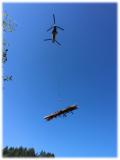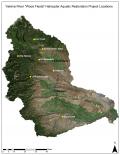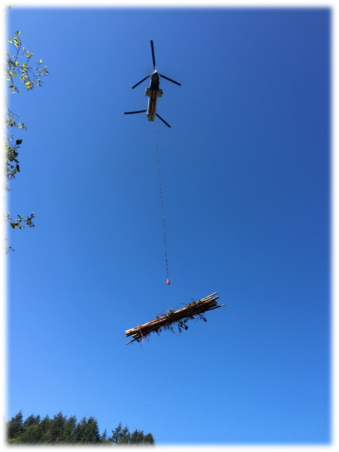The Yakima Basin "Wood Fiesta" Helicopter Aquatic Restoration project is a multi-watershed collaborative effort aimed at enhancing aquatic habitat in remote watersheds that have been greatly altered by past management practices. Large wood will be placed in stream and on the floodplain of seven Yakima River tributaries using a helicopter to improve habitat for native fish species. The projects are located in remote areas where terrain and or vegetation limits the use of ground-based equipment to place large wood. More information on these projects and associated temporary impacts to public access can be found below.
Project locations and temporary restrictions to public access:
Restrictions to public access are required during implementation due to hazardous conditions including falling trees and other debris.
(Check back as this table will be updated regularly with new developments)
Project Location |
Description |
Recreational Impacts |
| Lick Creek |
Project will restore 1 mile of Lick Creek with 500 habitat logs, beginning approximately 1.5 miles from the confluence with the NF Teanaway River. |
No major impacts. Project is planned for October 15, 2018 |
| Swauk Creek |
Project will restore 1 mile of stream with 500 habitat logs within the lower 4 miles of Swauk Creek. |
No major impacts. This project is located on private property and is planned for the October 13, 2018. |
| Umtanum Creek | Project will restore 4.5 miles of Umtanum Creek with 1000 habitat logs starting 1-mile above its confluence with the Yakima River. | The Umtanum Creek Recreation Site, including access over the blue suspension bridge, will be closed October 11th and 12th, 2018. Shooting areas will be closed on the east side of Durr Road between North Durr parking area and the Umtanum Creek parking area (south of Umtanum Creek bridge). |
| NF Manastash Creek | Project will restore lower 8 miles of NF Manastash Creek with 2000 habitat logs. | No major impacts. Project is planned for the week of October 1, 2018. |
| Little Naches River | Project will restore 1.5 miles of the Little Naches River near the Lost Meadow Campground with 1000 habitat logs. | The rock quarry at the end of Rd 1900-760 will be closed from September 10 to November 15, 2018. Project is planned for the week of November 5, 2018. |
| Little Rattlesnake Creek | Project will restore the lower 5 miles of Little Rattlesnake Creek with 500 habitat logs. | Expect traffic delays along Cowpuncher Ridge on DNR greendot road R5400; project is planned for November 9th and 10th. |
| Satus Creek | Project will restore 3 miles of Satus Creek with 400 habitat logs on the Yakama Nation Reservation. | No major impacts. Project is planned for the week of October 29, 2018. |
For more info on the benefits of wood in streams, click on the links below:
National Forest Foundation: Seven Reasons Why Fish Need Wood
Filson: Giving Rivers Back To Fish
The Nature Conservancy: Fish of the Forest- Large Wood Benefits Salmon Recovery
Partnerships
The "Wood Fiesta" is a large scale restoration effort that would not be possible without partnerships among many organizations. Within the Yakama Nation, the Yakama Reservation Watershed Project and The Wildlife Program are jointly responsible for implementing the Satus Creek Project. The Yakima Klickitat Fisheries Project is responsible for implementing the remaining six project locations. Mid-Columbia Fisheries Enhancement Group is a cosponsor at two locations, including the Little Rattlesnake and North Fork Manastash Projects. The Washington Department of Fish and Wildlife (WDFW) and The Nature Conservancy are completing forest health thinning projects; as a result some of the streams are using thinned trees from forest health work. WDFW, as well as the Washington Department of Natural Resources and the USDA Forest Service are managers where several projects are occurring; they have been supportive through the permitting processes. Finally, the Swauk Creek project is located on private land and could not happen without the support of affected landowners.
In addition, funding support for this effort comes from the Bonneville Power Administration, McNary Mitigation Fund, Yakima Basin Integrated Plan, Salmon Recovery Funding Board, United States Fish and Wildlife Service, Washington Wildlife and Recreation Program, Natural Resources Conservation Service and The Nature Conservancy.
The project is permitted and scheduled for implementation between October 1 and November 15, 2018.




